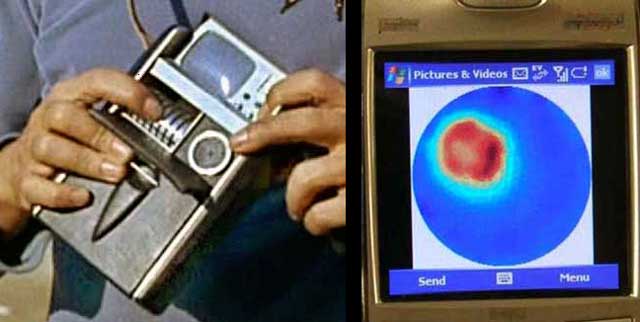Real Trekkie Tricorder Invented

New handheld medical scanners coupled with regular cell phones resemble "Star Trek" tricorders and could see what ails you with a push of a button.
The invention, using off-the-shelf cell phone technology, would allow medical scanners could boldly go where none have gone before — to the aid of the roughly three-quarters of the world's population currently without access to ultrasounds, X-rays and other imagers used for everything from detecting tumors to monitoring fetuses.
In addition to offering medical scans in developing nations, the devices "could find their way in ambulances, or rural clinics," said Boris Rubinsky, a professor of bioengineering at the University of California, Berkeley.
Medical imagers are typically bulky combinations of scanners, processors and video monitors. Rubinsky and his colleagues instead physically separated these components, so the most complicated elements of imagers — the powerful computer processors — can reside at a remote central location.
The researchers next devised a simple portable scanner that could plug into a cell phone. The phones transmit the raw scanning data to the processors, which create images to relay back for viewing on the cell phone screen.
Cheaper approach
The surprisingly simple setup is described in the April 30 issue of the journal PLoS ONE.
Sign up for the Live Science daily newsletter now
Get the world’s most fascinating discoveries delivered straight to your inbox.
The scheme would significantly lower the cost of medical imaging because one processor facility could serve multiple imagers.
"You could be out in the middle of a remote village and still have cell phone access," said researcher Antoni Ivorra, also at Berkeley.
The portable scanner was hooked up to a cell phone with a USB cable and tested on a gel-filled container that simulated breast tissue afflicted with a tumor. Diseased tissue conducts electricity differently than healthy tissue does. The image that was sent back had the simulated tumor clearly visible onscreen.
Simple and flexible
These devices could work with any cell phone that can send and receive pictures or audio and video clips.
"The size of the data in the study was only six kilobytes, which is ridiculously small," explained researcher Yair Granot at Berkeley. "A one sentence, text-only e-mail message is bigger than that."
Rubinsky noted that "people are able to watch full movies on their iPods" so cell phone screen sizes should not be a major impediment.
In the future, ultrasound scanners could also couple with cell phones. Just the ultrasound scanner "might cost about $1,000, while a whole ultrasound machine with all the other components might be about $70,000," Rubinsky told LiveScience. "We could take medical imaging and possibly benefit the entire world."
Simply donating existing medical scanners to the world's poorest regions is not a viable, long-term solution, Rubinsky said.
"More than half of the medical equipment in developing countries is left unused or broken because it is too complicated or expensive to operate and repair," he explained. "We set out to develop something that locals could sustain on their own, as well as something that is relevant to local economies and technologies."
Broad implications
These portable scanners "could open up whole new avenues of health care for the developing world," Rubinsky said. "Health professionals in rural clinics could affordably get the tools they need to properly diagnose and treat their patients."
Although diagnosis and treatment of roughly one-fifth of all diseases can benefit from medical imaging, "this advancement has been out of reach for millions of people in the world because the equipment is too costly to maintain," Rubinsky said. "Our system would make imaging technology inexpensive and accessible for these underserved populations."
The scanners could have broad applications in the developed world, too, he said.
"Health professionals in rural clinics could affordably get the tools they need to properly diagnose and treat their patients," Rubinsky said. "If you had a car accident, you could put a cap on the hat of the victim in the ambulance, and before the ambulance even gets to the hospital, all the information can go through the cell phone, maybe to spot if that person has internal bleeding in their head."
- The Next Step: Wild New Technologies
- T-shirt Monitors Heart Rate
- Quiz: Great Inventions










